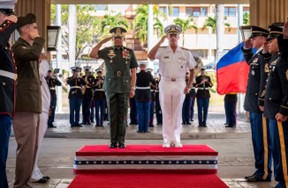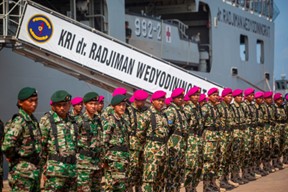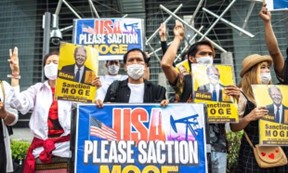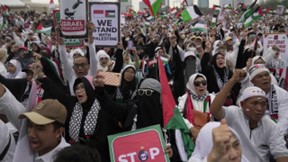Articles
US relations with Southeast Asia ended on a down note in 2023 with the last-minute failure to finalize the trade pillar of the Indo-Pacific Economic Framework (IPEF). This was not a complete loss for ASEAN states that managed to negotiate bilateral supply chain resilience agreements. However, it underscored the fact that broad regional frameworks, particularly for trade, are off the table with Washington, at least until the United States is past the November 2024 elections. Instead, the administration focused on security over trade and on key partners in the region, with Biden skipping the East Asia Summit (EAS) in Jakarta for a visit to Vietnam and the announcement of the US-Vietnam Comprehensive Strategic Partnership. In this period, US relations with the Philippines continued to strengthen, with Washington issuing three statements calling out China for its reckless maneuvers in the Philippines’ Exclusive Economic Zone in the South China Sea. But if some Southeast Asians were miffed by the administration’s focus on bilateralism over regionalism, most were reassured by Biden’s meeting with Xi Jinping on the margins of the APEC meeting in San Francisco.
In a statement issued by the ASEAN Foreign Ministers at year’s end, the meeting was cited as an encouraging step, although the overall tone of the statement was one of concern over threats to the “Southeast Asian maritime sphere.”
Worldwide, the final months of 2023 were marked by reaction to the war between Israel and Hamas, but the conflict had a measurable impact on Southeast Asia; this was particularly the case with Indonesia and Malaysia, both of which have Muslim-majority populations. A protracted war in the Middle East will return counterterrorism to the front burner of US relations with the maritime states of the region in 2024. Closer to home, the internal conflict in Myanmar worsened. Washington announced sanctions on the Myanmar Oil and Gas Enterprise (MOGE), the military’s most lucrative source of funds, but by year’s end there was no sign of a drop in the violence or of prospects for negotiations among the parties.
Strengthening Partnerships
As the target of the bulk of China’s harassment in the South China Sea in late 2024, the Philippines has reclaimed its more activist status on maritime issues that former President Rodrigo Duterte forfeited in exchange for expected economic bounty from Beijing. That reward did not materialize, and Duterte’s lowest ratings in public opinion polls were for his willful disregard of the growing threat from Chinese vessels in the Philippines’ Exclusive Economic Zone (EEZ). Current President Ferdinand “Bongbong” Marcos, Jr’s public embrace of the US-Philippine alliance and his agreement to expand the number of “flexible basing” sites under the US-Philippines Enhanced Defense Cooperation Agreement (EDCA) left little doubt of where Manila stood on maritime issues, although Marcos has been careful to keep lines of communication with Beijing open.
In return, Washington has been quick to respond to conflict in the Philippines’ EEZ with statements criticizing China’s behavior. After the Oct. 22 incident in which Chinese vessels collided with Philippine boats near the Second Thomas Shoal, the US moved ships and aircraft closer to the Philippines. On Oct. 28 the USS Ronald Reagan, the US Navy’s only forward-deployed aircraft carrier, arrived in Manila on a port call. On Nov. 3 the guided-missile destroyer USS Dewey carried out freedom of navigation operations near the Spratly Islands. As a sign of Manila’s own commitment to the stronger alliance, on Nov. 19 President Marcos and Philippine Armed Forces Chief Gen. Romeo Brawner, Jr., visited the Indo-Pacific Command in Honolulu. It is unusual for a head of state to visit the Command, and Marcos was the first Philippine president to do so.

Figure 1 Adm. John C. Aquilino, the commander of U.S. Indo-Pacific Command, is seen on the right, standing alongside Gen. Romeo Brawner, Jr., Chief of Staff of the Armed Forces of the Philippines, during an honors ceremony at the USINDOPACOM headquarters in Camp H.M. Smith, Honolulu, on November 17, 2023. Photo: John Bellino
Marcos has also made efforts to expand security relations with other like-minded countries, particularly Japan. Manila was the first recipient of Japanese Official Security Assistance (OSA) after Tokyo announced the new program in April 2023, and expects to receive the transfer of an air radar system. Moreover, the Philippines and Japan are in the process of negotiating a Reciprocal Access Agreement (RAA), which would enable Filipino and Japanese troops to enter one another’s territory for training exercises.
Marcos also stirred interest in November when he proposed that the other Southeast Asian claimants to the Spratly Islands—Vietnam and Malaysia—craft a separate code-of-conduct in the absence of progress on the larger China-ASEAN Code of Conduct on the South China. Hanoi and Kuala Lumpur appear lukewarm at best to the proposal, but it recalls Manila’s activism on maritime issues last seen during the presidency of Benigno Aquino.
Public debate in the Philippines points to growing nervousness that Manila’s and Washington’s strategic aims may not always be aligned, particularly over Taiwan. The most northern point of the Philippines is 100 miles from Taiwan, and Filipinos on the northern islands worry that the new EDCA sites could be a magnet for Chinese aggression if conflict breaks out in the Taiwan Strait. Administration officials in Manila publicly downplay these fears, pointing out that the sites would enable the US and Philippine militaries to respond more quickly to natural disasters in the north and, more to the point, could evacuate the more than 150,000 Filipino workers in Taiwan if conflict did erupt. However, the Philippine Congress has opened debate on the limits of the alliance with the United States, spearheaded by the president’s sister, Sen. Imree Marcos.
Vietnam
Velocity was also a dynamic in Washington’s relations with Hanoi in late 2023. When President Biden arrived in Hanoi on Sept. 9, it was widely expected that the United States and Vietnam would elevate relations from a Comprehensive Partnership to a Strategic one; instead, in a surprising leap the two leaders announced that a full Comprehensive Strategic Partnership had been agreed upon. This put the United States on the same level with China, Russia, India, and South Korea. (Hanoi subsequently added Japan to its list of Comprehensive Strategic Partnerships and intends to do with Australia as well.)
It was important to Hanoi that Biden’s co-signer on the US-Vietnam Comprehensive Strategic Partnership and the host for his visit was Vietnamese Communist Party Secretary-General Ngyuen Phu Trong, rather than President Vo Van Thuong or Prime Minister Pham Minh Chinh. A US president is both head of state and head of government, and therefore both Thuong and Chinh are Biden’s counterparts. However, the symbolism of the Biden-Trong pairing was an acknowledgment of the VCP’s political role in Vietnam. Biden’s visit was the follow-on next step to Trong’s visit to Washington in 2016, the first time a Vietnamese party chief had ever made an official trip to the United States.

Figure 2 US President Joe Biden addresses a press conference in Hanoi on Sept. 10, 2023. Photo: Evan Vucci
Washington’s overall aim for the visit was to strengthen US-Vietnam relations through as many avenues as possible. However, the joint statement detailing the Comprehensive Strategic Partnership did not address security; given their sensitivities, advances in this area were likely be discussed and negotiated away from the spotlight of a presidential visit. This began a week later in Washington at the annual US-Vietnam Defense Policy Dialogue, in which enhanced cooperation on defense industry and trade, maritime security, information sharing, cybersecurity, and humanitarian missions.
More under the radar are discussions on US arms transfers to Vietnam, the prohibition of which was lifted by President Barack Obama in 2016. Since then, however, sales have been a modest $365 million, a small fraction of Russia’s weapons sales to Vietnam. The pace of Hanoi’s purchase of US arms is affected in part by the need to avoid riling China with a dramatic expansion. Political concerns still come into play on the US side, although the transfer of lethal arms to Vietnam is allowed under US law if the president deems them important to “the free and open navigation of the South China Sea.”
Without doubt, Vietnam’s immediate interest in negotiating the Comprehensive Strategic Partnership was economic. Hanoi is determined to expand US investment in Vietnam and exports to the United States, but Washington endeavors to pull Vietnam into its supply chains, particularly in semiconductors and critical minerals. South Korean investment in Vietnam is lagging; moreover, Hanoi is attempting to attract foreign technology companies that are amenable to arrangements that will transfer technology to Vietnamese companies. US companies are in their sights, and early deliverables in the new partnership reflected that: the US-Vietnam Semiconductor Partnership to Support Resilient Semiconductor Supply Chains; the Workforce Initiative To Support Semiconductor Capacity; and the Developing Electronics and Leading Technology Advancement (DELTA) Partnerships.
Since normalization in 1995, the US-Vietnam relationship has depended on implied linkages between areas of cooperation. Progress in the security relationship accelerated when the United States included more war legacy issues, particularly remediation of dioxin, in the policy mix. In its own right, investment in Vietnam is a priority for US companies as they continue to redirect manufacturing away from China. That said, an increase in US investment in Vietnam will likely lead to gains on the security side, although those will always be cautious and incremental.
Regional Steps
As great power competition rises in the Indo-Pacific, ASEAN endeavors to develop regime mechanisms, particularly in maritime security. On Sept. 19-23, the 10 ASEAN nations, with East Timor participating as an observer, conducted the group’s first-ever joint military exercises. Led by Indonesia, the 2023 ASEAN chair, the exercises were maritime-based with a focus on humanitarian assistance and disaster relief. The venue was chosen to avoid contested areas; after some controversy, a course was designed beginning in the southern area of the Natuna Sea and concluding near the island of Batam, south of Singapore.

Figure 3 Military personnel participate in the opening ceremony of the ASEAN Solidarity Exercise joint-military drills at Batu Ampar port on Batam island, Indonesia, on September 19, 2023. Photo: Antara Foto
The momentum behind these exercises clearly came from the maritime states, and it was doubtful that they would have been launched without Jakarta’s chairmanship this year. Although ASEAN has conducted military exercises as a group with external powers, particularly the United States, ASEX 23 was ASEAN’s first stand-alone exercises in that they were restricted to ASEAN itself.
Beyond the obvious threat posed by Chinese incursions into ASEAN EEZs, there were several reasons to develop greater regional capacity. Foremost are natural disasters, which are almost certain to increase in number and severity. As well, the need to evacuate civilians in a security crisis; the benefits of acculturation among the ASEAN militaries; and the likely need for greater cooperation in counterterrorism are all served by joint exercises. However, development in this area is unlikely to be an easy trajectory: the annual rotation of ASEAN chairs, some of which will be more reluctant than others, will slow the process down.
Jakarta’s final act as the 2023 chair was ASEAN’s release of a joint statement by the foreign ministers on Dec. 30, expressing concern over events in the South China Sea in the past year and expressing the need for greater focus on the Southeast Asian “maritime sphere.” This was an implicit expression of ASEAN solidarity with the Philippines’ position, at least on Chinese attempts to disrupt the navigation of Southeast Asian vessels in their countries’ own EEZ’s. However, whether Laos as the 2024 ASEAN chair will actively take up this issue, much less maintain the momentum created in 2023, is doubtful.
Myanmar Sinks Further
Throughout 2023 the ASEAN Five-Point Consensus Plan, forged in April 2021 two months after the military coup against the newly elected civilian government, remained the policy of record for both ASEAN and the West. However, Jakarta was able to do little to move the plan forward. Although Myanmar remains an ASEAN member, and is likely to do so, Naypyidaw was not invited to the group summits in 2023, although it continued to participate in ASEAN events at the working level, including the September joint military exercises. The group refrained from officially recognizing either the junta or the opposition, the National Unity Government (NUG), although Jakarta made attempts to increase contact with the NUG. Western governments, including the United States, followed ASEAN’s lead in that regard. With continued tensions in the Taiwan Strait; the conflict in Ukraine; and the eruption of war in the Middle East, no one was eager to spark a proxy war in Myanmar.
However, in October Washington tightened sanctions on Myanmar and designated the Myanmar Oil and Gas Enterprise (MOGE) for restrictions. MOGE is Myanmar’s most lucrative state-owned enterprise and provides the junta with much-needed revenue. This builds upon recent US sanctions which targeted individuals and entities providing jet fuel to the military in an attempt to prevent airstrikes on civilian populations. Overseas Burmese opposition groups had long pressed the United States to sanction MOGE. Washington’s hesitation in this regard was based on two risks: that Thailand, which continues to rely upon Myanmar for some of its natural gas supply, will oppose it, and that the move will push the junta closer to Moscow, which provides energy to the military at bargain rates.

Figure 4 A group of activists in Tokyo call on the US government to sanction the Myanmar Gas and Oil Enterprise. Photo: Philip Fong/AFP/Getty Images
In 2023 the internal conflict in Myanmar spread, and the United Nations estimates that it now ranges over two-thirds of the country. In October, the People’s Defense Force (PDF), the military arm of the opposition, allied with anti-junta ethnic groups in northern Shan State to push the military out of some enclaves. This places Beijing in a dilemma. Security along the border in Shan State is important for the export of critical minerals from Myanmar into China. At the same time, military clashes with the PDF and a surge in drug trafficking and other transnational crime threaten the steady flow of this cross-border trade. China’s interests are best served by allying with whoever controls northern Shan State, whether it is the military or the opposition. However, in the western Rakhine State, its interests are clearly with the military, to protect the Chinese oil and gas pipelines and for the planned construction of a deep seaport on the Bay of Bengal.
In the meantime, living conditions and the economy continue to deteriorate in Myanmar and the delivery of humanitarian assistance is impeded by both the military and the opposition. The October surge of fighting in Shan State displaced nearly half a million civilians, bringing the total of IDPs to roughly 2 million since the 2021 coup. The World Bank measures current inflation in Myanmar at 20% and predicts economic growth for 2024 at 1% at best. In contrast to other ASEAN states, whose economies have recovered from the COVID-19 pandemic, Myanmar’s economy is 10% below 2019 levels.
Distant Wars, Local Impact
To protect its security and its economic growth, Southeast Asia endeavors to remain neutral in most conflicts outside the region — “ASEAN centrality” is as much a geographic expression as a political one. Despite continued pressure from the West, particularly the United States, ASEAN sidesteps attempts to take a common position against Russia on the war in Ukraine. With global energy and food prices high—and likely to rise further with the war in the Middle East—Southeast Asian countries continue to import Russian energy and grain, often at discounted prices. This will continue in 2024 as the region moves closer to a crisis in food security, brought on by high prices but also by the impact on rice production during an “El Niño year.”
The outbreak of war in October between Israel and Hamas presents a different problem for Southeast Asia. ASEAN does not take a common position on the Israeli-Palestinian conflict, and there is no outside pressure to do so. As with the war in Ukraine, a spectrum of positions has opened in ASEAN on the crisis. Singapore is the most forward-leaning country in supporting Israel and deploring the Oct. 7 attacks. It has a long and close relationship with Israel, which was the first country to offer Singapore diplomatic recognition after independence.
Thailand and the Philippines have several common problems in the Middle East conflict. Both have significant groups of guest workers in Israel and, to a lesser degree, in Gaza; and both have Muslim minority populations in their southern regions which are tied to separatist movements. Thai and Filipino workers suffered casualties on Oct. 7 and several were taken hostage. Both countries have been able to secure the release of some of their hostages, working through Egypt, but are under increasing domestic pressure to free the remainder.
The conflict will be felt more strongly in Muslim Mindanao in the southern Philippines, where there is more international involvement with local jihadist movements, than in southern Thailand, where the separatist movement is more locally based. The terrorist attack on Mindanao State University in Marawi on Dec. 3 likely signals a return to pre-pandemic violence. These factors require Bangkok and Manila to walk a fine line in public statements on the crisis. Bangkok has declared itself “neutral,” claiming that it does not take sides; in Manila, President Marcos issued a statement that deplored the attack on Israel but also urged Tel Aviv to lift the siege on Gaza.
The war in the Middle East has particular resonance in the domestic politics of Indonesia and Malaysia, both of which are Muslim-majority countries and neither of which recognizes Israel. As Indonesia prepares for elections in February and the ruling coalition in Malaysia attempts to hold onto power, candidates and leaders are attempting to maintain political equilibrium while the count rises of Palestinian civilians killed in bombings in Gaza.
Indonesian President Joko Widodo and Malaysian Prime Minister Anwar Ibrahim have come out firmly on the Palestinian side, although they have been careful not to sanction the Oct. 7 attack by Hamas. In statements, Jakarta and Kuala Lumpur have alluded to the Israeli occupation of Palestinian territories as a cause of the current crisis. Anwar echoed Jordan’s Queen Rania when he accused the United States and other Western countries of applying a double standard and valuing the lost lives of Israelis more than those of Palestinians. Indonesia and Malaysia also signed the Oct. 18 statement by the Organization of Islamic Cooperation (OIC) condemning Israel for its assault on Gaza following the Oct. 7 attack.
These positions track with previous statements from Jakarta and Kuala Lumpur, but the Israel-Hamas war has particular resonance with the Indonesian and Malaysian populations at this time. Indonesia will hold elections in February and faces the transition to a new president; in Malaysia, Anwar is attempting to tamp down a surge in the political popularity of PAS, the longstanding fundamentalist opposition party. Pro-Palestinian demonstrations have been widespread across Indonesia, and security forces are tracking heightened terrorist threats— the Israeli siege of the Indonesian hospital in northern Gaza in November was particularly inflammatory.

Figure 5 Protesters shout slogans and wave Palestinian flags during a rally in support of the Palestinians in Gaza, at the National Monument in Jakarta on Nov. 5, 2023. Photo: Dita Alangkara via AP
But the greater risks for Indonesia, Malaysia and the southern Philippines lie in the possibility of a protracted and expanded war in the Middle East. Apart from greater public anger in domestic populations, an expanded war will prompt Middle Eastern terrorist groups to seek recruits from Southeast Asia, as ISIS did during the Iraq War. Most of the overseas fighters from that war have returned to Southeast Asia and been reintegrated, but there will be ample fodder in the region for a new recruitment, particularly if it is accompanied by economic inducements.
Continuation and expansion of the conflict will be problematic for US relations with Southeast Asia, particularly with Washington’s strong identification with Israel at this time. An enhanced terrorist threat in Southeast Asia will call for stronger counterterrorism cooperation with the United States, particularly in the Philippines and Indonesia. Counterterrorism is woven into the US-Philippines alliance and although it is more ad hoc in US-Indonesian relations it nevertheless is an important element in the bilateral security relationship. Counter-terrorism cooperation with Malaysia is focused more on intelligence-sharing than military response but that too will rise with a wider conflict.
The shadow of Iran will also lengthen over US relations with Southeast Asia if the war expands. Hezbollah cells have been detected in the region in the past, usually attempting to attack Western companies or tourists. However, some Southeast Asia companies can be caught up in US sanctions aimed at Tehran. On Dec. 19 Washington imposed sanctions on 10 entities and four individuals based in Indonesia, Iran, Hong Kong, and Malaysia for facilitating Iran’s procurement of sensitive materials used in the production of attack drones.
Over the Horizon
In 2024 three elections in the Asia-Pacific will have an impact, directly or indirectly, on Southeast Asia: in Taiwan on Jan. 13; in Indonesia on Feb. 14; and in the United States on Nov. 5. The Taiwanese elections will only impact Southeast Asia if the outcome, most likely a victory for the Democratic Progressive Party, worsens the security environment in the Strait and more broadly the South China Sea.
At this point, Defense Minister Prabowo Subianto has the lead in public opinion surveys on the February polls in Indonesia. Elections in that country are an elongated process: the inauguration of the new president will not take place until October. If Prabowo prevails, given past frictions with Washington over human rights issues, relations with the United States will initially focus on some fence-mending and confidence-building, as they did with the Philippines when Marcos was elected in 2022. However, that will be a more uncertain process if the Israel-Hamas war is ongoing. That is likely, as Israeli Prime Minister Netanyahu was said that he expects operations in Gaza to continue through the year.
The greatest impact on Washington’s relations with Southeast Asia will be the outcome of the United States’ own elections in November. Southeast Asian leaders are reconciled to the fact that a regional trade agreement is off the table with either a Democratic or Republican president. However, signals from the camp of former President Donald Trump of stronger trade protectionism in a second term are worrisome, particularly since Trump applied punitive measures to countries that had trade surpluses with the United States in his first term. In Southeast Asia, only Singapore has a trade deficit with the United States—even Myanmar has a surplus that is four times the size of its imports from the US.
Trump’s “America First” approach to security alliances is also worrisome to Southeast Asians, particularly the Philippines. They fear that the United States will abandon its “pivot” to the Indo-Pacific, if only temporarily during the election campaign, and that US distraction will invite further Chinese adventurism in the South China Sea. Historically, Southeast Asians have tended to favor Republican US presidents, because they were viewed as more attendant to security issues, but the pendulum has swung to the Democrats in the 2024 elections. With the expectation that Washington will be more distant, or even absent, in regional affairs, Southeast Asians will focus on expanding security relations with other powers, particularly Japan.
These fears are exacerbated by the fact that ASEAN itself will be distracted and to some degree disunited in 2024. There is scant hope for a resolution to the conflict in Myanmar, and Vientiane is unlikely to make stringent efforts to implement the Five-Point Consensus Plan. Continuing the ASEAN move toward regional maritime security cooperation will require freelance efforts from Indonesia, Malaysia, and the Philippines. However, with Malaysia taking the ASEAN chair in 2025 and the Philippines in 2026, Kuala Lumpur and Manila will be particularly vigilant on security in ASEAN affairs in 2024.